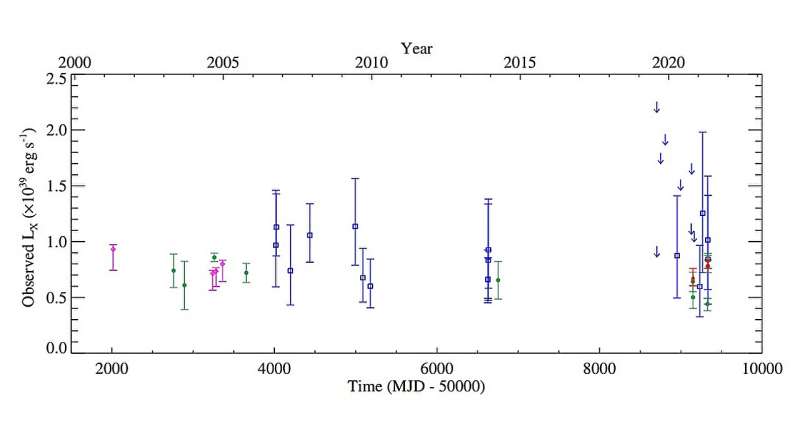January 11, 2024 report
This article has been reviewed according to Science X's editorial process and policies. Editors have highlighted the following attributes while ensuring the content's credibility:
fact-checked
peer-reviewed publication
trusted source
proofread
NGC 2403 XMM4 is a super-Eddington neutron star, study finds

By analyzing the data from various space telescopes, astronomers have performed a detailed study of an ultraluminous X-ray source known as NGC 2403 XMM4. Results of the study, published January 5 in the Monthly Notices of the Royal Astronomical Society journal, indicate that this source is a neutron star accreting at super-Eddington rates.
Ultraluminous X-ray sources (ULXs) are point sources in the sky with typical X-ray luminosities at a level of 1.0 duodecillion erg/s. They are less luminous than active galactic nuclei (AGN), but more consistently luminous than any known stellar process. Although numerous studies of ULXs have been conducted, the basic nature of these sources still remains unsolved.
NGC 2403 XMM4 is a ULX in the spiral galaxy NGC 2403 located some 13.7 million light years away. Previous studies have found that it is a low-luminosity ULX and suggested that it may be a sub-Eddington intermediate mass black hole.
In order to shed more light on the properties of NGC 2403 XMM4, which could unveil its true nature, Wasutep Luangtip of the Srinakharinwirot University in Bangkok, Thailand, and Timothy P. Roberts of Durham University in Durham, UK, have combed through the archival X-ray data. They analyzed 20 years of observational data from XMM-Newton, Chandra, Swift and NuSTAR space telescopes.
"Given that NGC 2403 has been observed multiple times by various observatories since the beginning of this century, including several observations in the current decade, there is now sufficient archival data to provide us with the opportunity to analyze this source in detail," the researchers explained.
By investigating the 20-year light curve of NGC 2403 XMM4, Luangtip and Roberts found that most of the time its X-ray luminosity is below 1.0 duodecillion erg/s. However, given that NGC 2403 XMM4 is above the luminosity threshold for ultraluminous X-ray sources, its spectral behavior does appear distinctly ULX-like.
According to the authors of the paper, these findings indicate that NGC 2403 XMM4 is accreting at super-Eddington rates. This hypothesis is also supported by broadband spectroscopic data showcasing the presence of a steep high energy tail.
The time averaged X-ray luminosity of NGC 2403 XMM4 was estimated to be about 0.5 duodecillion erg/s and the emission from the source was found to be isotropic. Based on this, the astronomers estimate that the object has a mass lower than 3.8 solar masses, which suggests that it is a neutron star, accreting at a rate of 1.3–3.2 times Eddington.
Summing up the results, the astronomers noted that despite not making the ULX threshold, NGC 2403 XMM4 exhibits many behaviors and characteristics consistent with super-Eddington accretion.
All in all, the collected data point to the presence of a neutron star that is an accreting object in this system. This is therefore the third super-Eddington neutron star detected in NGC 2403.
More information: Wasutep Luangtip et al, NGC 2403 XMM4: evidence for a super-Eddington neutron star with a possible transient pulsation, Monthly Notices of the Royal Astronomical Society (2024). DOI: 10.1093/mnras/stae023. On arXiv: DOI: 10.48550/arxiv.2401.02177
Journal information: Monthly Notices of the Royal Astronomical Society , arXiv
© 2024 Science X Network





















